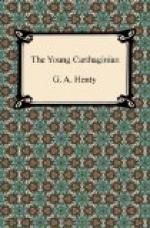The work of soothing had then to be repeated, until at last most of the riders brought their lions’ skins and lay down by the prostrate horses, with their heads upon their necks. The animals, trained thus to sleep with their riders by their side, and reassured by the presence of their masters, were for the most part content to lie quiet, although the packs of wolves, attracted by the scent of the meat that had been cooked, approached close to the camp and kept up a dismal chorus round it until morning.
Day by day the march was continued. The country was wild and rugged, foaming torrents had to be crossed, precipices surmounted, barren tracts traversed. But after a week’s hard marching the column had overcome the greater part of the difficulty, had crossed the Sierras and gained the plateau, which with a gradual fall slopes west down to the Atlantic, and was for the most part covered with a dense growth of forests. They now to their satisfaction overtook the main body of the army, and their marches would be somewhat less severe, for hitherto they had each day traversed extra distances to make up for the two days’ loss in starting. Here Malchus for the first time saw the bands of Gaulish mercenaries.
The Spanish troops had excited the admiration and astonishment of the Carthaginians by their stature and strength; but the Gauls were a still more powerful race. They belonged to the tribes which had poured down over the Apennines, and occupied the northern portion of Spain long anterior to the arrival of the Carthaginians. Their countenances were rugged, and as it seemed to Malchus, savage. Their colour was much lighter than that of any people he had yet seen. Their eyes were blue, their hair, naturally fair or brown, was dyed with some preparation which gave it a red colour.
Some wore their long locks floating over their shoulders, others tied it in a knot on the top of their heads. They wore a loose short trouser fastened at the knee, resembling the baggy trousers of the modern Turks. A shirt with open sleeves came halfway down their thighs, and over it was a blouse or loose tunic decorated with ornaments of every description, and fastened at the neck by a metal brooch. Their helmets were of copper, for the most part ornamented with the horns of stags or bulls. On the crest of the helmet was generally the figure of a bird or wild beast. The whole was surmounted by immense tufts of feathers, something like those of our Highland bonnets, adding greatly to the height and apparent stature of the wearers.
The Gauls had a passion for ornaments, and adorned their persons with a profusion of necklaces, bracelets, rings, baldricks, and belts of gold. Their national arms were long heavy pikes — these had no metal heads, but the points were hardened by fire; javelins of the same description — these before going into battle they set fire to, and hurled blazing at the enemy — lighter darts called




